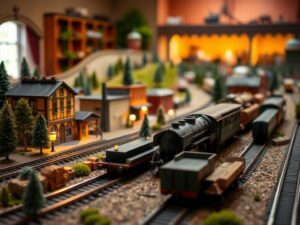Guide to Installing DCC Signal Systems in HO Scale Layouts
Guide to Installing DCC Signal Systems in HO Scale Layouts
Guide to Installing DCC Signal Systems in HO Scale Layouts
Hey there fellow railfans! Today, let’s talk about bringing your HO scale layouts to life with the magic of DCC signal systems. If youâve ever dreamed of having realistic train movements complete with flashing lights and synchronized signals, this guide is for you.
Even if youâre new to DCC (Digital Command Control), don’t worry! I’ll walk you through the fundamentals, explain essential components, and offer practical advice every step of the way.
Why Choose DCC Signal Systems?
Forget about clunky hand throws and constant fiddling with manual controls. With DCC signal systems in HO scale, your trains become autonomous passengers on an intricate digital network. This brings a level of realism and immersion to your layout that simply can’t be achieved with traditional methods.
Hereâs why youâll love DCC signals:
- Realism: Imagine a vibrant scene where red lights warn your engines of imminent stops, green signals beckon them forward, and flashing yellow signifies caution.
- Automation: Program signal sequences based on realistic scenarios. No more manual switches! Your trains will follow predefined routes effortlessly.
- Interactivity: Many DCC systems allow you to remotely control individual signals for dynamic operations. Imagine adjusting signals mid-run or adding unexpected diversions to your track!
DCC Signal Basics: What You Need
Before we dive into the installation process, letâs familiarize ourselves with the essential components of a DCC signal system:
1. The Decoder: Every DCC locomotive (and some other rolling stock) requires a decoder. Think of this as a tiny computer chip that translates digital signals from your controller into physical movements. Some decoders also come equipped with features like sound and light control.
2. Signal Modules: These miniature electronic brains handle the logic behind your signal lights. Youâll need modules for each set of signals you want to install on your layout.
3. Railsound: Many enthusiasts integrate a dedicated audio decoder into their locomotives to provide realistic sounds of engines, whistles, and bells.
4. Controller (Command Station): This is your control center for the entire DCC system. Use it to throttle your trains, program signals, and manage various aspects of your layout.
Installing Your DCC Signal Systems
Now that you know the basic building blocks, let’s get our hands dirty! Remember: Always disconnect power before working on any electrical components in your layout.
1. Planning Your Layout:
* Sketch out your track plan and identify locations for signals.
* Consider signal spacing based on your scale and the realistic operational flow of your train lines.
2. Signal Wire Wiring:
Connect each signal module to its respective rail sections using insulated wire (like #24 AWG). Each module typically has separate wires for:
- Common positive (+) rail
- Signal red (-)
- Signal yellow (-)
-
Signal green (-)
Tip: Ensure you use good-quality wiring connectors for secure and reliable connections.
3. Connect to Command Station: Connect your signal modules’ common wire (+) to a DCC accessory bus on your command station or control panel. This establishes the power link.
4. Test and Configure Signals: Once everything is wired, double-check each connection and test the signal functions using your DCC controller. Follow manufacturer instructions to configure signaling options and logic for different signals on your layout.
Common DCC Signal Types
1. Simple Light Signaling: These signals use three basic colors â red, yellow, and green â to convey basic indications like stop, caution, and proceed.
2. Flashing Lights: For added realism, incorporate flashing lights in red or yellow positions to signal diverging routes or special warnings.
3. Searchlights/Beacon Lights: These can add dramatic visual appeal and indicate the location of important junctions or areas within your layout.
4. Route-Specific Signals: Advanced setups allow for more intricate signaling logic. Signals might flash or change colors based on a specific train’s type or direction, reflecting real-world signal control procedures.
Essential Tools & Materials
- Wire Strippers/Cutters: Precision tools for neat wiring jobs.
-
Screwdriver Set: For attaching components and terminals.
-
Soldering Iron (Optional): While connectors are typically preferred, soldering offers extra security and can be helpful in tight spaces.
-
Heat Shrink Tubing: For insulating connections and preventing shorts.
-
DCC Signal Modules: Choose from a variety of modules based on your desired signal types and layout complexity.
Expert Tips for Successful Installation:
-
Keep it Organized: As you install signals, label wires and components to prevent confusion later on.
-
Signal Positioning: Consider signal visibility from both operator’s viewing perspective and the train driver’s view (scale-wise).
-
Use Prototypical Color Schemes: Many resources provide authentic color guidelines for various signal types. Research them to add that extra touch of realism!
-
Test Thoroughly: Always test your signals after each stage of installation to ensure they function correctly and meet your desired operation logic.
-
Embrace the Community:
Model railroading is all about sharing experiences and knowledge. Don’t hesitate to reach out to online forums, local clubs, or experienced hobbyists for assistance or inspiration. Remember, even seasoned veterans started as beginners!
I hope this guide empowers you to transform your HO scale layout into a vibrant, fully functional railway with authentic DCC signal systems. Enjoy the journey of learning and creating something truly remarkable!
Happy Railfanning!




